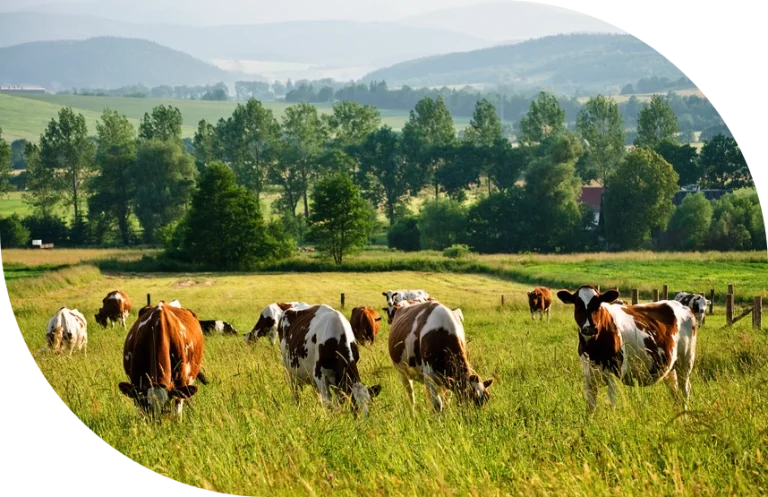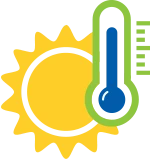Managing Heat Stress in Dairy Cows - A new Approach with nu.biom BOS
UNDERSTANDING HEAT STRESS
Heat stress occurs when a cow’s ability to dissipate body heat is overwhelmed by environmental conditions, resulting in a disruption of its thermal balance. Unlike humans, cattle begin to suffer from heat stress at relatively moderate temperatures due to their higher metabolic heat production and limited thermoregulatory mechanisms—they do not sweat and primarily rely on increased respiration to release heat.
The severity of heat stress is most effectively assessed using the Temperature-Humidity Index (THI), which combines ambient temperature and relative humidity into a single value. As THI increases, the risk of heat stress and its impact on health and productivity becomes more significant.

HEAT STRESS RISK LEVELS AND RUMEN HEALTH IMPLICATIONS
While the Temperature-Humidity Index (THI) provides the most accurate assessment of heatstress risk, ambient temperature alone can offer a practical approximation:

| Ambient Temp (°C) | Approx. THI | Stress Level |
|---|---|---|
| < 21°C | < 68 | No Stress |
| 21–25°C | 68–72 | Mild Stress |
| 26–30°C | 73–78 | Moderate Stress |
| 31-35°C | > 79 | Severe/High Stress |
| > 35°C | > 84 | Emergency/Critical |
MANIFESTATIONS OF HEAT STRESS IN DAIRY COWS
Heat stress triggers a range of behavioral and physiological responses in dairy cows. These signs can be earlyindicators of thermal discomfort and declining performance:
Behavioral Signs:
- Increased respiratory rate and panting
- Reduced feed intake
- Higher water consumption
- Standing more frequently to improve heatdissipation
- Actively seeking shade or air movement
Physiological Signs:
- Elevated core body temperature(above 39.5°C)
- Open-mouth breathing and drooling
- Reduced rumination and altered rumenmotility
- Increased heart rate
Recognizing these symptoms promptly is essential for implementing timely mitigation strategies andpreventing long-term impacts on animal welfare and productivity.
EFFECTS ON PRODUCTION AND HEALTH
Heat stress has significant consequences on dairy cow performance and overall health. The impactis both immediate and long-term, affecting productivity, reproduction, and metabolic stability.
Production:
- Reduced milk yield: losses of up to 10–25% during moderate to severe heat stress
- Altered milk composition: decreased fat and protein content, increasedsomatic cell count
- Lower feed efficiency: more energy diverted to cooling rather than production
General Health:
- Increased incidence of mastitis, laminitis, and metabolic disorders
- Suppressed immune function, increasing vulnerability to disease
- Body weight loss and decline in body condition score
Reproductive Health:
- Weakened expression of estrus
- Reduced conception and embryo survival rates
- Hormonal imbalances affecting reproductive cycles
Proactively addressing heat stress is essential to maintaining herd performance,animal welfare, and economic sustainability.
OPTIMIZING INTESTINAL BALANCE AND RUMINANT PERFORMANCE nu.biom BOS:
What is nu.biom BOS?
nu.biom BOS is a postbiotic, a preparation of non-living microbial cells, their components, or metabolites that exert beneficial effects on the host. It is rich in unique bioactive compounds derived from bacterial fermentation processes that provides immunomodulatory, anti-inflammatory, antioxidant, and antibacterial benefits, rumen and intestinal health in general.
Unlike traditional postbiotics based on yeast, nu.biom BOS offers keyadvantages:
- Broader Metabolic Profile – Bacterial strains produce a wider range ofbioactive metabolites.
- Optimized Bioavailability – The metabolites are naturally suited for uptake bythe gut microbiota.
- Precision – Designed for precision microbial modulation in ruminants.
- Synergistic Strain Combination – Multiple proprietary strains work together todeliver diverse and complementary bioactivities.
How nu.biom BOS helps cows cope with heat stress?
 Supports gut barrier integrity
Supports gut barrier integrity
- Heat stress compromises the intestinal lining, leading to increased permeability (“leaky gut”).
- nu.biom BOS delivers bioactive metabolites that strengthen tight junctions and support gut lining regeneration.
- Result: Reduced endotoxin (LPS) and bacterial leakage, preserving immune efficiency and milk production.
 Modulates rumen microbial balance
Modulates rumen microbial balance
- Heat stress compromises the intestinal lining, leading to increased permeability (“leaky gut”).
- nu.biom BOS delivers bioactive metabolites that strengthen tight junctions and support gut lining regeneration.
- Result: Reduced endotoxin (LPS) and bacterial leakage, preserving immuneefficiency and milk production.
 Delivers anti-inflammatory metabolites
Delivers anti-inflammatory metabolites
- nu.biom BOS contains bioactive compounds such as short-chain fatty acids(SCFAs), peptides, and cell wall components that naturally modulateimmune responses.
- Result: Reduced systemic inflammation, better energy partitioning, andimproved metabolic focus on milk production
 Boosts antioxidant capacity
Boosts antioxidant capacity
- Oxidative stress is a major consequence of heat stress due to excessive reactive oxygen species (ROS) and disruption of antioxidant systems.
- nu.biom BOS enhances antioxidant defense mechanisms, includingupregulation of super-oxide dismutase (SOD) and glutathione pathways.
- Result: Reduced cellular damage and improved resilience of metabolicsystems.
 Stabilizes feed intake & energy utilization
Stabilizes feed intake & energy utilization
- Heat stress significantly decreases feed intake (DMI), affecting energyavailability for milk production, reproduction and overall
- health.nu.biom BOS improves rumen function and feed palatability, helpingmaintain nutrient intake during hot periods.
- Result: Stabilized milk yield and better efficiency in nutrient conversion.

